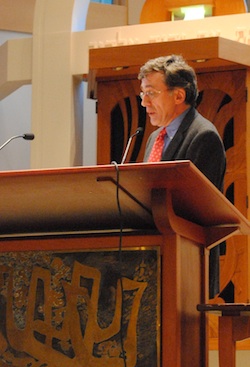By Charlene Kahn , Special to JTNews
The plotlines of a political thriller are all contained within the complex, tangled web of the modern Middle East and its often misunderstood history. For three weeks, Resat Kasaba, director of the Jackson School of International Studies at the University of Washington, discussed the ever-changing region and its “sequel,” the explosive, unpredictable — and still ongoing — Arab Spring, with both origins and parallels from 100-plus years earlier.
Adult learners at Temple Beth Am received insight and a broader understanding on the subject from the Turkish-born Kasaba, an expert in Middle Eastern history with a focus on the Ottomans, as he sorted through this tangled web.
“People were excited to hear this scholar’s approach and his research,” said Linda Capell, who, with her husband Peter, co-chaired Beth Am’s University Lecture series that had a focus on the Arab Spring.
“Professor Kasaba was recommended,” Capell said. “The [advantage of the] lecture series gives scholars the opportunity to go into depth. It’s research-based.”
Kasaba used his opening lecture, “Three Empires to Many States: Middle East in the Twentieth Century” to provide what he called a context to what’s happening in the Middle East today.
He started by outlining facts: The 600-year reign of the Ottoman Empire with its strong political center defined the Middle East during that time, ruling over a “multiplicity of identities” such as Greeks, Turks and Jews. The major relationships were between empire and its subjects. The break-up into nation-states, “particularly messy in the Middle East,” he said, was complicated by the involvement of the European powers, primarily Great Britain and France, who were there to serve their own interests, and not those of the native populations.
“One unified space now was divided into 20 nation-states,” Kasaba said.
Referencing three secret and contradictory agreements — the Sykes-Picot Treaty, British support of the Arab Revolt, and the Balfour Declaration — “all impossible to follow,” Kasaba said, he proceeded to tell the story of the social and national implications of each.
He presented slides of these diplomatic documents and photographs, augmenting with statistics and readings of original quotes, which provided further dimension to the complexity of the period.
“It’s extremely important to understand the events of World War I and the post-war era,” Kasaba said. “The boundaries set by 1920 became the future Middle East.”
Those comments set the stage for his next talks, in which he discussed the ramifications all the way up to the events of the past 18 months that have changed the face of the Arab world.
Many of the attendees commented that they had been unaware of the political and geographic implications unleashed by the carving up of the region.
Several of the attendees came because of Kasaba’s reputation as a speaker.
“It’s pertinent to everything that’s going on in the world,” said local author and Beth Am member Jackie Williams. “Professor Kasaba is very straightforward, makes salient points without editorializing, and he’s organized, so you can follow. I’ve read the history many times, but I could never repeat it.”
Event co-chair Peter Capell said Kasaba’s talks provided important background.
“If you don’t know the history and background leading to the Arab Spring, then you can’t understand or interpret how people or countries will be affected or respond,” he said.
Kasaba’s expertise in the factual disciplines of sociology and demography, the use of statistics to study population, and his advocacy of a long-term, reflective approach proved useful in explaining the foundational issues behind the changes in the Middle East, many still to come.
As a self-declared optimist, Kasaba often referred to the necessity of hope in the lives of people in the Middle East.
“At the crux,” he said, discussing the Arab Spring in his second lecture, “was lack of hope in the future; this is the fundamental issue for young people. You have to give people a reason to hope.”
